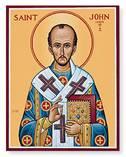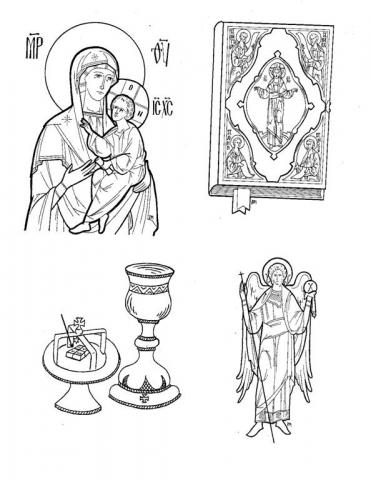St. John Chrysostom and the Liturgy
ST. JOHN CHRYSOSTOM AND THE DIVINE LITURGY
Objectives:
 Students should be able to say the name, St. John Chrysostom, and tell his story.
Students should be able to say the name, St. John Chrysostom, and tell his story.- Students should know that he wrote the Divine Liturgy we celebrate most Sundays.
Possible Lesson Plan:
- Open with prayer.
- Tell the story of St. John Chrysostom:
St. John Chrysostom was born about 300 years after the time of Christ in the city of Antioch in the land of Syria. His parents, Secounthos and Anthousa, were very rich. They became Christians before John was born, and John was baptized when he was very young. Secounthos died when John was a boy, and Anthousa taught him carefully about Christ Jesus and the Christian life.
When he became a young man, John went to Athens to study in the university there. In Athens, he soon became known for his wonderful preaching. He became famous all through the land. In face, his name “Chrysostom” is not his last name at all but means “Golden-Tongued” and was given to him because of his wonderful speaking. One day, John was telling men who believed in other gods about the Lord Jesus. One of these men, Anthemios, fell down to the ground shaking after denying the true God. John prayed for Anthemios and he was healed. Anthemios and many others of the learned men then became Christians and were baptized.
When John finished his schooling, he returned to Antioch and became a monk. During this time, many people who were sick came to him for prayer and were healed. Some farmers even came to him because they were afraid of a lion which killed many people. John told them to pray to God and gave them a wooden cross to place on the road. The next morning, the lion was found dead in front of the cross. St. John lived in the monastery for four years, performing many miracles and serving as an example of Christian life. He then left the monastery to live alone in the desert a life of prayer. But, John became ill and had to go back to Antioch. He was ordained a deacon and served the Patriarch, St. Meletios, for five years.
When Patriarch Meletios died, the new patriarch, Flavianos, saw a vision telling him to take John to Constantinople and there ordain him a priest. The next day, they left Antioch for Constantinople. As the patriarch was ordaining John, a white dove appeared and sat on John’s head, showing the blessing of the Holy Spirit. (What other time did the Holy Spirit appear as a dove?) John went back to Antioch as a priest. Soon, the Patriarch of Constantinople died and John was named patriarch. He had to be sneaked away from Antioch in a carriage because the people loved him so much they did not want him to go. During John’s time as Patriarch of Constantinople, John continued to preach the Word of God with great wisdom. He also wrote many books of sermons and interpretations, composed hymns, and gave us the Divine Liturgy still celebrated today.
But, John was never afraid to speak out against those who did not live the way of Christ. Because of this, he made many enemies, including the emperor’s wife, whom he criticized for her greedy and selfish way of life. Finally, she brought a list of lies against John to the bishops and had John sent away. The people tried to stop this, and hundreds of Christians were killed by the empress’s army. John spent his last four years as a simple priest in the village of Cacussus.
Add St. John Chrysostom to your timeline.
- True/False Questions:
True False
“Chrysostom” means “Golden tongued”. John’s last name was Chrysostom.
The lion was killed in front of cross. The lion died in front of a mouse.
A dove sat on John’s head. A crow sat on John’s head.
John was Patriarch of Constantinople. John was Patriarch of Jerusalem.
- St. John Chrysostom (Have the children repeat his name.) wrote the Divine Liturgy as we celebrate it most Sunday’s of the year. Have the children repeat until they can say correctly “divine liturgy”. Explain that this is the special service that we have to worship God. Review the parts of the liturgy; children should be able to chime in with answers as they recognize the things they have heard and sung for years:
- Litany: Here we pray for the whole world. Who else do we pray for? (travelers, prisoners, leaders of our country, bishops, priests, deacons, rain and sun, food to eat, and we especially remember Mary the Theotokos) What do we respond? (Lord have mercy. Grant it, O Lord.)
- Hymns of worship: 1st and 2nd antiphons, troparia and kontakia, Trisagion -- review these words. Try singing the antiphons we use each Sunday.
- Epistle and Gospel: Here we hear God’s word from the Bible. God speaks to us from His special book, the Gospel Book, which is kept on the altar table. The priest carries out the Gospel and tells us to pay attention to God’s word.
- Cherubic Hymn: God makes us His special guests, along with the seraphim and cherubim, His angels in heaven. The priest uses incense as he prays, reminding us that the prayers go up to God the same way the smoke rises. The discos holds the holy bread and the chalice the communion wine. The tabernacle on the altar holds communion for those who are sick and cannot come to church. The priest carries the chalice and discos in the Great Entrance, while praying for us all!
- Creed: We all recite the creed –review the writing of the creed by the Fathers of the Church in Nicaea under Constantine the Great.
- Preparation for Communion: Review the story of the Last Supper. Here the priest prays for the bread and wine to become the true body and blood of Jesus. We say “Amen” and bow to the altar.
- The Megalynarion: We honor Mary the Theotokos with a special hymn.
- The Lord’s Prayer: Can we say it together? Jesus gave us this prayer himself.
- Holy Communion: Review crossing the arms, opening the mouth, kissing the chalice. Have the children practice this.
- Benediction: The priest blesses us and dismisses us. We all kiss the Cross.
- Make a Liturgy Book for each child. They can use these in Liturgy to help them remember the parts of the service. Take 4 pieces of paper and fold in half. Staple all together in the middle. On the front write “My Liturgy Book”. On the first page, print “Litany” and draw some of the things we pray for in the litany – an airplane or car or train or boat, fruit or vegetables, sun, prison bars, red cross for hospital, Orthodox cross for the church. On the next page, print “Hymns” and try some musical notes. Next print “Holy Bible” and draw a picture of the Bible, then “Cherubic Hymn” with an angel to represent the cherubim (Do you remember the various “ch
 oirs” of angels from the lesson on Revelation?). Then print “Creed” with a picture of Constantine, or just a crown. “Preparation for Communion” with bread and a chalice follow, then “Megalynarion” with a small picture of Mary (We have lots of these in our old bulletin covers file.). “The Lord’s Prayer” with praying hands would be next, then “Holy Communion” with the chalice and bread again, and finally “Benediction” and a cross to kiss. If drawing these themselves takes too long, use stickers for some. Here are also some pictures that will help.
oirs” of angels from the lesson on Revelation?). Then print “Creed” with a picture of Constantine, or just a crown. “Preparation for Communion” with bread and a chalice follow, then “Megalynarion” with a small picture of Mary (We have lots of these in our old bulletin covers file.). “The Lord’s Prayer” with praying hands would be next, then “Holy Communion” with the chalice and bread again, and finally “Benediction” and a cross to kiss. If drawing these themselves takes too long, use stickers for some. Here are also some pictures that will help.
Too complex? Use the pages below and just fill in and color:
- Close with prayer: Lord, help me to use my tongue to speak only what you want me to say.